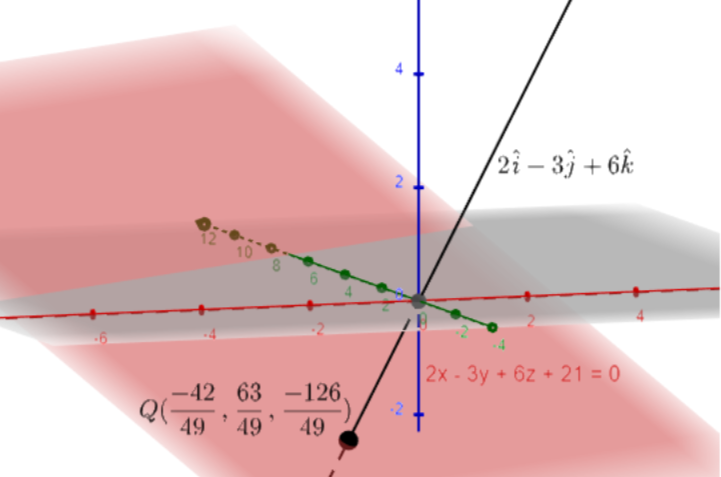
Find the length of the perpendicular drawn from the origin to the plane $2x-3y+6z+21=0$
Answer
573.9k+ views
Hint: Use the fact that the perpendicular drawn from the origin to this plane is parallel to the plane’s normal vector. Observe that the vector representing this perpendicular will be a scalar multiple of the normal vector (since they are parallel). Use this to find the foot of the perpendicular lying on the plane. This point must satisfy the equation of the plane. Then use the distance formula to find the length of the perpendicular.
Complete step-by-step solution:

Let the point $Q\ (a,b,c)$ denote the foot of the perpendicular drawn from the origin $P\ (0,0,0)$ to the plane $2x-3y+6z+21=0$ .
We note that $\overrightarrow{PQ}=(a-0)\hat{i}+(b-0)\hat{j}+(c-0)\hat{k}=a\hat{i}+b\hat{j}+c\hat{k}$
Also, the normal vector of the given plane is $\overrightarrow{n}=2\hat{i}-3{j}+6{k}$
Since both $\overrightarrow{n}$ and $\overrightarrow{PQ}$ are perpendicular to the given plane, we see that $\overrightarrow{n}$ is parallel to $\overrightarrow{PQ}$ (i.e. $\overrightarrow{PQ}=\lambda \vec{n}$ ). Hence we obtain
$a\hat{i}+b\hat{j}+c\hat{k}=2\lambda \hat{i}-3\lambda \hat{j}+6\lambda \hat{k}$
Comparing the components on both sides, we obtain
$a=2\lambda ,\ b=-3\lambda ,\ c=6\lambda $
However, since $Q\ (a,b,c)$ lies on the given plane, it must satisfy its equation. Hence
$2a-3b+6c+21=0\Rightarrow 2(2\lambda )-3(-3\lambda )+6(6\lambda )+21=0\Rightarrow 49\lambda +21=0\Rightarrow \lambda =-\dfrac{21}{49}$
Therefore, the foot of the perpendicular drawn from the origin to the given plane is $Q\ \left( -\dfrac{42}{49},\dfrac{63}{49},-\dfrac{126}{49} \right)$ .
In the end, we use the distance formula to compute the length of this perpendicular.
$\left|\overrightarrow{PQ} \right|=\dfrac{1}{49}\sqrt{{{42}^{2}}+{{63}^{2}}+{{126}^{2}}}=\dfrac{1}{49}\sqrt{{{21}^{2}}\left( {{2}^{2}}+{{3}^{2}}+{{6}^{2}} \right)}=\dfrac{21\cdot 7}{49}=3$
Hence, the length of the perpendicular from the origin to the plane $2x-3y+6z+21=0$ is $3$.
Note: Observe how it is important to be able to identify those vectors which are perpendicular or parallel to the normal vector of the given plane and use it to your advantage. In general, the length of the perpendicular from a point $({{x}_{1}},{{y}_{1}},{{z}_{1}})$ to the plane $ax+by+cz+d=0$ could also be directly calculated by using the formula:
$d=\dfrac{\left|a{{x}_{1}}+b{{y}_{1}}+c{{z}_{1}}+d \right|}{\sqrt{{{a}^{2}}+{{b}^{2}}+{{c}^{2}}}}$ .
Complete step-by-step solution:

Let the point $Q\ (a,b,c)$ denote the foot of the perpendicular drawn from the origin $P\ (0,0,0)$ to the plane $2x-3y+6z+21=0$ .
We note that $\overrightarrow{PQ}=(a-0)\hat{i}+(b-0)\hat{j}+(c-0)\hat{k}=a\hat{i}+b\hat{j}+c\hat{k}$
Also, the normal vector of the given plane is $\overrightarrow{n}=2\hat{i}-3{j}+6{k}$
Since both $\overrightarrow{n}$ and $\overrightarrow{PQ}$ are perpendicular to the given plane, we see that $\overrightarrow{n}$ is parallel to $\overrightarrow{PQ}$ (i.e. $\overrightarrow{PQ}=\lambda \vec{n}$ ). Hence we obtain
$a\hat{i}+b\hat{j}+c\hat{k}=2\lambda \hat{i}-3\lambda \hat{j}+6\lambda \hat{k}$
Comparing the components on both sides, we obtain
$a=2\lambda ,\ b=-3\lambda ,\ c=6\lambda $
However, since $Q\ (a,b,c)$ lies on the given plane, it must satisfy its equation. Hence
$2a-3b+6c+21=0\Rightarrow 2(2\lambda )-3(-3\lambda )+6(6\lambda )+21=0\Rightarrow 49\lambda +21=0\Rightarrow \lambda =-\dfrac{21}{49}$
Therefore, the foot of the perpendicular drawn from the origin to the given plane is $Q\ \left( -\dfrac{42}{49},\dfrac{63}{49},-\dfrac{126}{49} \right)$ .
In the end, we use the distance formula to compute the length of this perpendicular.
$\left|\overrightarrow{PQ} \right|=\dfrac{1}{49}\sqrt{{{42}^{2}}+{{63}^{2}}+{{126}^{2}}}=\dfrac{1}{49}\sqrt{{{21}^{2}}\left( {{2}^{2}}+{{3}^{2}}+{{6}^{2}} \right)}=\dfrac{21\cdot 7}{49}=3$
Hence, the length of the perpendicular from the origin to the plane $2x-3y+6z+21=0$ is $3$.
Note: Observe how it is important to be able to identify those vectors which are perpendicular or parallel to the normal vector of the given plane and use it to your advantage. In general, the length of the perpendicular from a point $({{x}_{1}},{{y}_{1}},{{z}_{1}})$ to the plane $ax+by+cz+d=0$ could also be directly calculated by using the formula:
$d=\dfrac{\left|a{{x}_{1}}+b{{y}_{1}}+c{{z}_{1}}+d \right|}{\sqrt{{{a}^{2}}+{{b}^{2}}+{{c}^{2}}}}$ .
Recently Updated Pages
A man running at a speed 5 ms is viewed in the side class 12 physics CBSE

The number of solutions in x in 02pi for which sqrt class 12 maths CBSE

State and explain Hardy Weinbergs Principle class 12 biology CBSE

Write any two methods of preparation of phenol Give class 12 chemistry CBSE

Which of the following statements is wrong a Amnion class 12 biology CBSE

Differentiate between action potential and resting class 12 biology CBSE

Trending doubts
What are the major means of transport Explain each class 12 social science CBSE

Which are the Top 10 Largest Countries of the World?

Draw a labelled sketch of the human eye class 12 physics CBSE

Explain sex determination in humans with line diag class 12 biology CBSE

Explain sex determination in humans with the help of class 12 biology CBSE

Differentiate between homogeneous and heterogeneous class 12 chemistry CBSE




